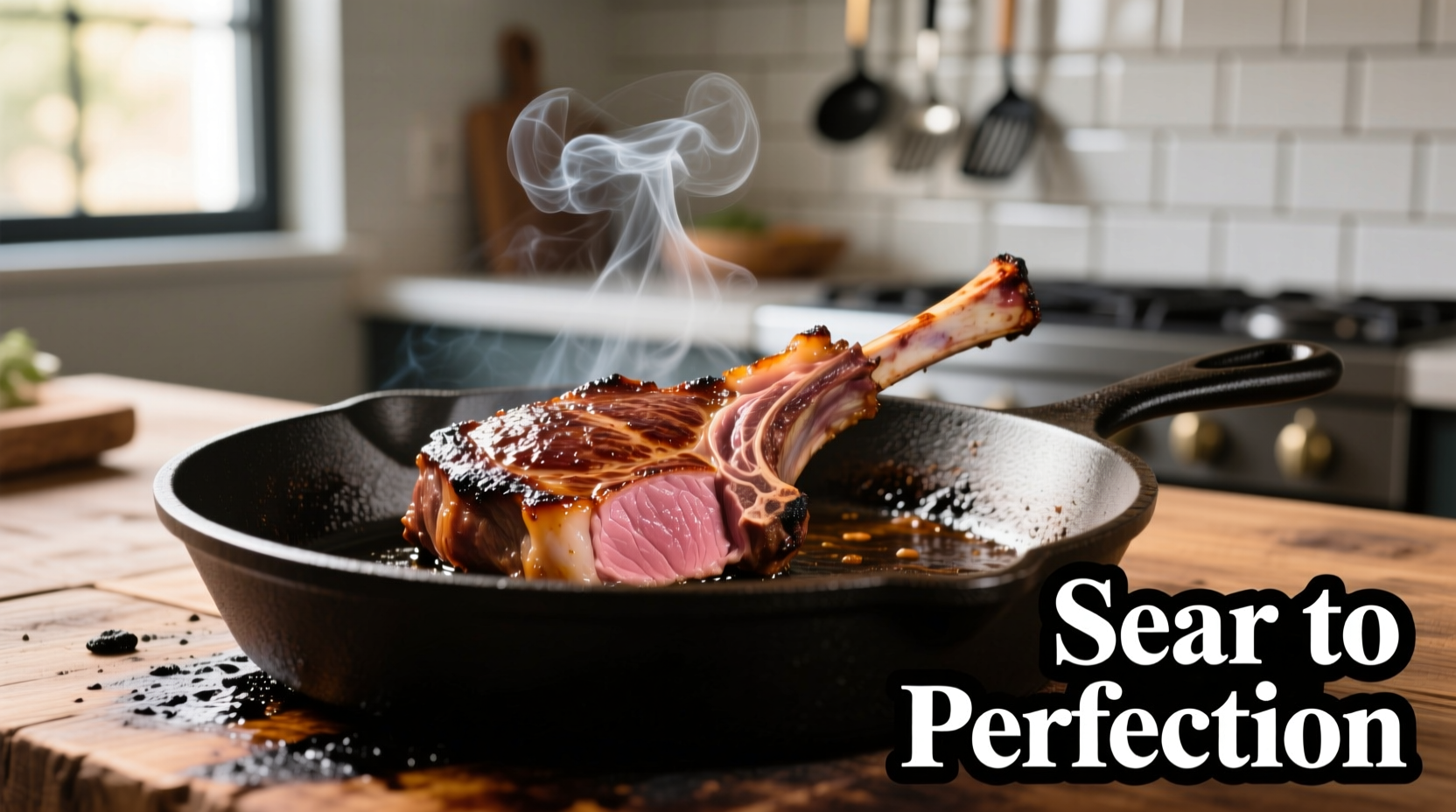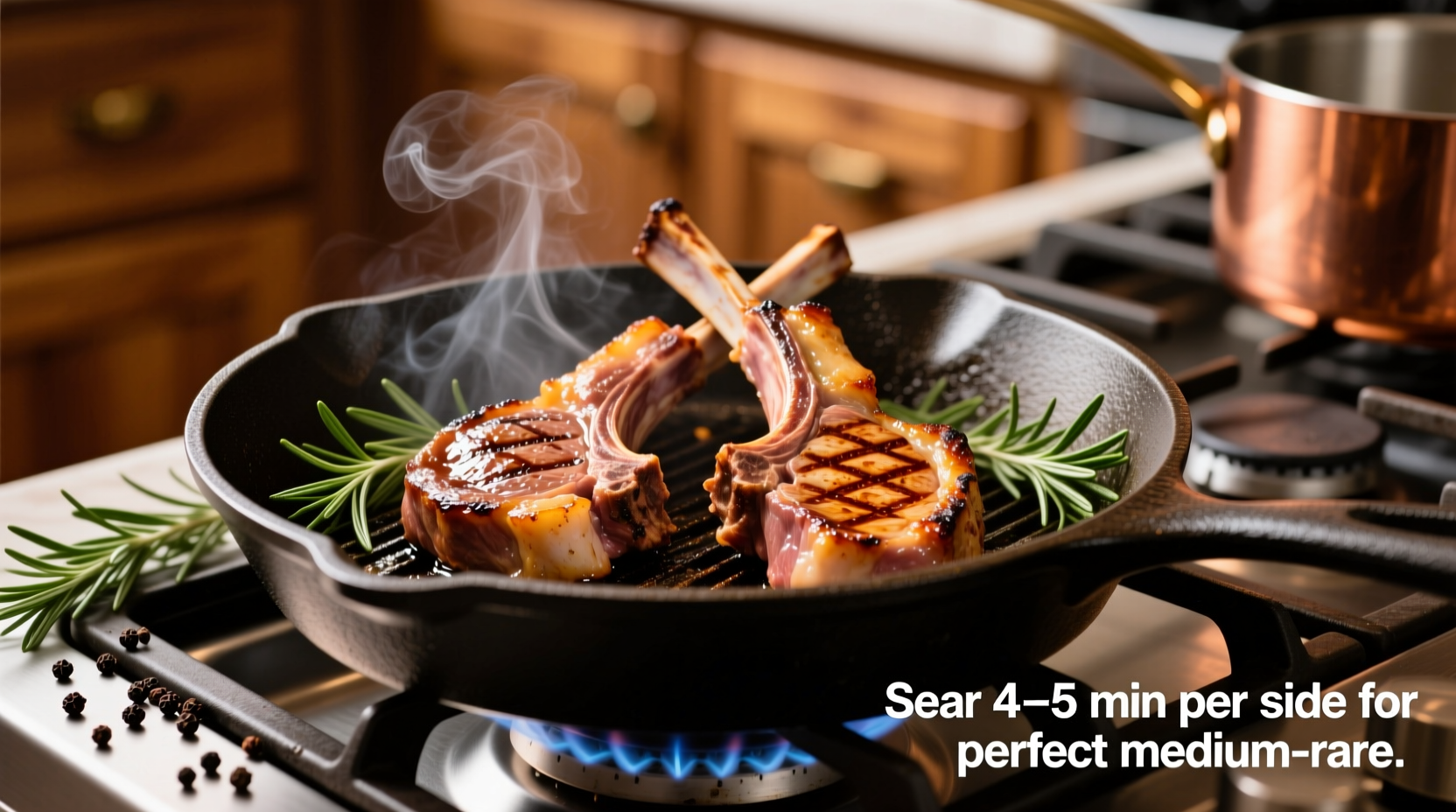Perfectly cooked lamb chops on the stove require 3-4 minutes per side for medium-rare, using a cast-iron skillet preheated to 400°F (204°C) with high smoke point oil. The internal temperature should reach 130-135°F (54-57°C) for optimal tenderness and flavor.
The Ultimate Guide to Stovetop Lamb Chops: Restaurant-Quality Results at Home
Nothing beats the sizzle of perfectly seared lamb chops hitting a hot skillet. This comprehensive guide delivers restaurant-quality results in your home kitchen with precise timing, temperature control, and professional techniques that guarantee tender, flavorful chops every time. Whether you're cooking for a special occasion or weeknight dinner, mastering stove-top lamb chops elevates your culinary skills while delivering impressive results with minimal equipment.
Why Stovetop Cooking Works Best for Lamb Chops
Lamb chops benefit from the intense, direct heat of stovetop cooking which creates the perfect Maillard reaction—those beautiful browned edges packed with complex flavors. Unlike thicker cuts that require oven finishing, lamb chops' ideal thickness (about 1-1.5 inches) makes them perfect for the skillet. The American Lamb Board confirms that quick, high-heat cooking preserves the delicate fat marbling that gives lamb its distinctive flavor profile.
Essential Equipment Checklist
Before you begin, gather these kitchen essentials:
- Cast-iron or heavy-bottomed stainless steel skillet (avoid non-stick for proper searing)
- Metal spatula or tongs for flipping
- Instant-read thermometer (critical for perfect doneness)
- Wire cooling rack
- Aluminum foil for resting
Selecting Quality Lamb Chops
Start with the right cut for best results. Loin chops ("T-bone" style) and rib chops ("lollipop" style) work exceptionally well for stovetop cooking. Look for:
- Vibrant pink to deep red meat color
- Marbling of creamy white fat throughout
- Fat cap no thicker than 1/4 inch
- "American Lamb" label for domestically raised quality
| Doneness Level | Internal Temperature | Visual Characteristics | Recommended Resting Time |
|---|---|---|---|
| Rare | 120-125°F (49-52°C) | Very red center, cool | 5 minutes |
| Medium-rare | 130-135°F (54-57°C) | Warm red center | 6 minutes |
| Medium | 140-145°F (60-63°C) | Pink center | 7 minutes |
| Medium-well | 150-155°F (66-68°C) | Slightly pink center | 8 minutes |
| Well-done | 160°F+ (71°C+) | Little to no pink | 10 minutes |
Source: USDA Food Safety and Inspection Service temperature guidelines for lamb
Step-by-Step Cooking Process
Preparation (15-30 minutes before cooking)
Remove chops from refrigerator 20-30 minutes before cooking. This critical step ensures even cooking—chilled meat seizes when hitting hot pans, leading to uneven results. Pat chops completely dry with paper towels; moisture is the enemy of proper searing. Season generously with kosher salt (about 1 tsp per pound) and freshly ground black pepper. For enhanced flavor, add rosemary or thyme sprigs directly to the pan during cooking.
The Perfect Sear (8-12 minutes total)
Heat your skillet over medium-high heat for 3-4 minutes until properly preheated. Add 1-2 tablespoons of high smoke point oil (avocado, grapeseed, or clarified butter). When oil shimmers but doesn't smoke, carefully place chops in skillet away from you to avoid oil splatter. Do not move them for the first 3-4 minutes to develop a proper crust.
Flip chops using tongs when they release easily from the pan (don't force them). Sear second side for 3-4 minutes for medium-rare. For thicker cuts (over 1.5 inches), tilt chops and sear the fat cap for 1-2 minutes to render excess fat. Add 2 tablespoons butter, crushed garlic, and fresh herbs during the last 2 minutes, basting the chops continuously for restaurant-quality flavor.

Resting and Serving
Transfer chops to a wire rack (not a plate) and tent loosely with foil. Resting for 5-10 minutes (depending on doneness level) allows juices to redistribute. Cutting too soon releases precious juices onto your plate instead of staying in the meat. The internal temperature will continue rising 5-10 degrees during resting (carryover cooking).
Common Mistakes That Ruin Lamb Chops
Avoid these frequent errors that turn premium lamb into disappointing meals:
- Skipping the dry step: Moisture prevents proper browning—pat chops thoroughly dry
- Overcrowding the pan: Causes steaming instead of searing—cook in batches if needed
- Using the wrong oil: Extra virgin olive oil burns at high temps—choose high smoke point oils
- Not using a thermometer: Visual cues alone are unreliable—invest in an instant-read thermometer
- Cutting too soon: Resting is non-negotiable for juicy results
When Stovetop Cooking Isn't Ideal
While stove-top excels for standard lamb chops, consider these limitations:
- Chops thicker than 1.5 inches benefit from finishing in a 400°F oven after searing
- Frozen chops require complete thawing in the refrigerator before cooking
- Very lean cuts (like some grass-fed options) may dry out faster—reduce cooking time by 30 seconds per side
- Electric coil stoves may create uneven heating—rotate chops 90 degrees halfway through cooking
Flavor Variations to Try
Once you've mastered the basic technique, experiment with these professional variations:
- Mediterranean style: Add lemon zest and oregano during the last minute of cooking
- Asian fusion: Replace butter with sesame oil and finish with a splash of soy sauce
- Garlic-herb crust: Press minced garlic and chopped herbs into chops before searing
- Spiced rub: Mix 1 tsp each cumin, coriander, and smoked paprika with salt before cooking
Perfect Pairings for Your Lamb Chops
Complete your meal with these complementary sides that enhance lamb's rich flavor:
- Crispy roasted potatoes with rosemary
- Grilled asparagus with lemon
- Minted pea puree
- Simple arugula salad with balsamic
Troubleshooting Guide
Encountering issues? Here's how to fix common problems:
- Burning oil: Reduce heat slightly and ensure proper preheating next time
- Sticking to pan: Wait longer before attempting to flip—properly seared meat releases naturally
- Uneven cooking: Press chops gently with spatula during first minute for better contact
- Overcooked: Next time reduce cooking time by 30 seconds per side and check temperature earlier











 浙公网安备
33010002000092号
浙公网安备
33010002000092号 浙B2-20120091-4
浙B2-20120091-4